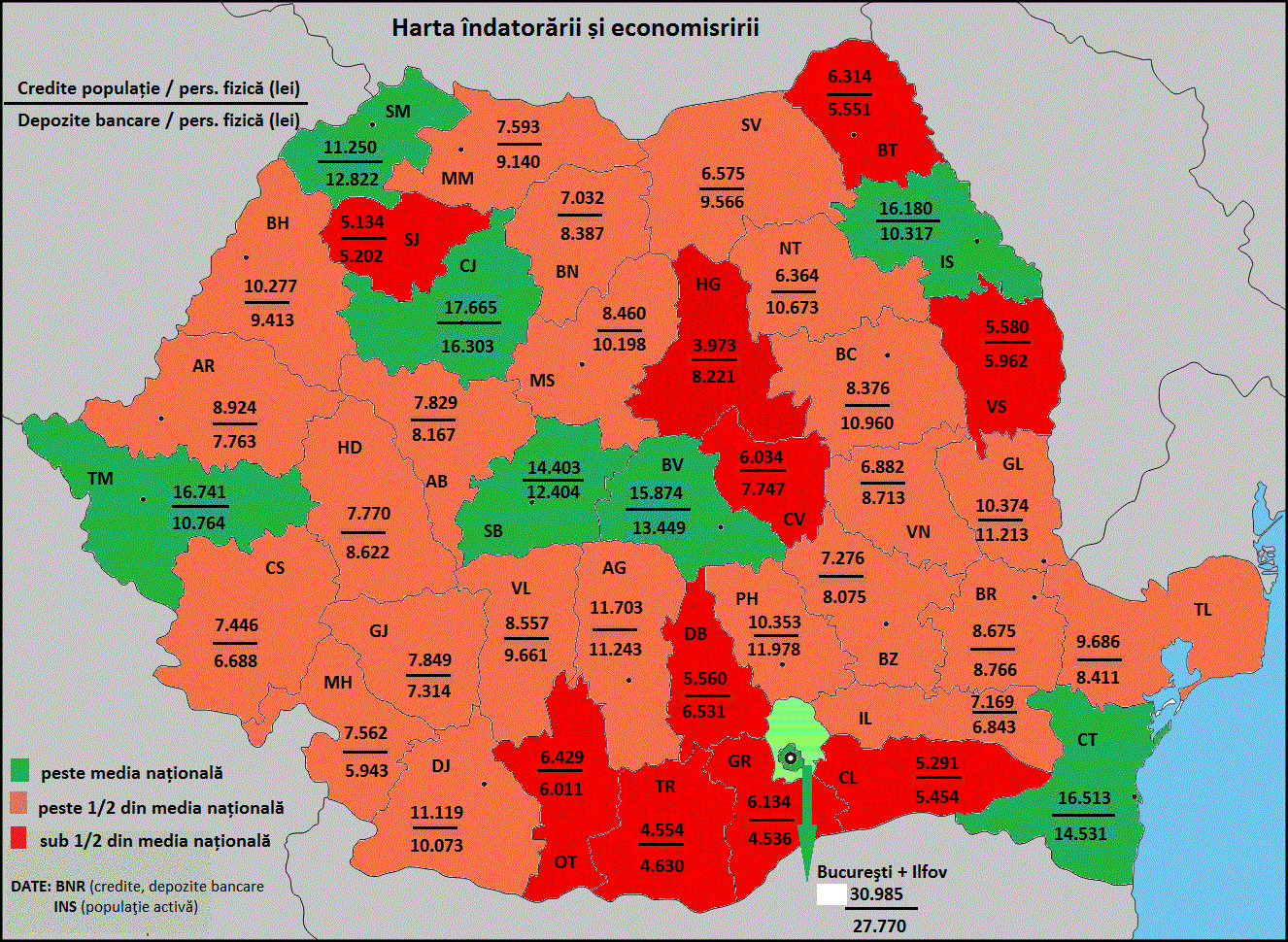 Statistics on the debt and saving capacity give a measure of the gap between developed and underdeveloped counties of Romania.
Statistics on the debt and saving capacity give a measure of the gap between developed and underdeveloped counties of Romania.
The counties where the population and companies save more have, on average, the highest level of loans relative to the number of active natural persons, respectively to the active legal persons, according to the latest comparative data of the National Bank of Romania, the National Institute of Statistics and the National Trade Register Office.
Debt capacity is about four times higher in the richest counties than the poorest
Only six counties plus Bucharest (including Ilfov) exceed the average credit per active Romanian active natural person, of over 13,000 lei: Cluj, Timis, Constanta, Iasi, Brasov and Sibiu.
Apart from the capital city, which (hors concours) holds the supremacy, as expected, at almost all the debt and saving averages, the highest county average credit per active natural person, of 17,665 lei, registered in Cluj, is 3.9 times above the poorest county in this respect, Teleorman.
The welfare that supports the debt capacity, measured by the average bank deposit of an active individual, shows a similar disproportion.
The largest average bank deposit (except for Bucharest), worth 16,303 lei, is again in Cluj county and is 3.6 times higher than the average of the last-ranked Giurgiu county.
Above the national average, of 12,327 lei, are also the counties Constanta, Brasov, Satu Mare and Sibiu.
„The counties with a lower degree of access to credit for the population also have a lower development. They had an average GDP per capita of 5,230 euros in December 2015,” according to the most recent report of the National Bank of Romania (BNR) on the financial stability.
Only a few counties register values of the average credits and bank deposits of an active individual high enough to raise the national average above the level of the other counties.
The counties that are below the national average levels can also be structured by the difference to this average.
The active population in 11 counties (Olt, Neamt, Botosani, Giurgiu, Covasna, Dambovita, Vaslui, Calaraşi, Salaj, Teleorman, Harghita) registers credit average levels of less than half of the national average.
Seven of the counties with the lowest credits also have, on average, the lowest bank deposits relative to their active population, below half the national average.
There are counties where loans are small, although savings are high.
People from Neamt register an average credit level 51% lower than the national average, although they have an average level of bank deposits 13% lower than the national average.
Inhabitants of Harghita and Covasna counties have the lowest average credits (69%, respectively 54% below the national average), although the saving gap is much smaller to the national average (- 33% and -37% respectively).
On the other hand, we have assigned the green colour on the above map to the people from Satu Mare, even if the average credit is 14% lower than the national average because they have savings in bank deposits above the national average. On the other hand, the active people from Timis and Iasi have savings below the average.
Companies
A company active in Romania has an average credit of over 129,000 lei and only eight counties including the capital city are above: Satu Mare, Sibiu, Gorj, Iasi, Alba, Dolj, Brasov.
The highest average credit per active company in a county (over 154,000 lei) is 4.1 times higher than the average of the poorest county. The statistical game makes Satu Mare the champion county and Giurgiu the laggard (again, the capital city is hors concours).
Of course, an average can be high because the reported value is high but also because the denominator is small and a county may have the merit of having managed to create the right conditions for even one big company, while maybe another county was not helped to have even one company that could have taken it out of poverty.
On the other hand, only companies in Sibiu, Bucharest (plus Ilfov) and Sibiu have bank deposits higher than the national average of 116,571 lei. In general, Romanian companies do not save, either because they don’t have anything to save and use the cash as much as possible, or they do not use bank deposits.









